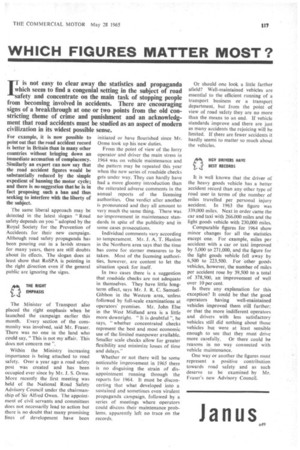WHICH FIGURES MATTER MOST?
Page 119

If you've noticed an error in this article please click here to report it so we can fix it.
/ T is not easy to clear away the statistics and propaganda which seem to find a congenial setting in the subject of road safety and concentrate on the main task of stopping people from becoming involved in accidents. There are encouraging signs of a breakthrough at one or two points from the old constricting theme of crime and punishment and an acknowledgment that road accidents must be studied as an aspect of modern civilization in its widest possible sense.
For example, it is now possible to point out that the road accident record is better in Britain than in many other countries without bringing down an immediate accusation of complacency. Similarly an expert can now say that the road accident figures would be substantially reduced by the simple expedient of banning the motor cycle; and there is no suggestion that he is in fact proposing such a ban and thus seeking to interfere with the liberty of the subject.
The same liberal approach may be detected in the latest slogan "Road safety depends on you" adopted by the Royal Society for the Prevention of Accidents for their new campaign. Although road safety propaganda has been pouring out in a lavish stream for many years, there are still doubts about its effects. The slogan does at least show that RoSPA is pointing in the right direction even if the general public are ignoring the signs.
nTHE RIGHT EMPHASIS
The Minister of Transport also placed the right emphasis when he launched the campaign earlier this month. Every section of the community was involved, said Mr. Fraser. There was no one in the land who could say, "This is not my affair. This does not concern me ".
Within the Ministry increasing importance is being attached to road safety. Over a year ago a road safety post was created and has been occupied ever since by Mr. J. S. Orme. More recently the first meeting was held of the National Road Safety Advisory Council under the chairmanship of Sir Alfred Owen. The appointment of civil servants and committees does not necessarily lead to action but there is no doubt that many promising lines of development have been initiated or have flourished since Mr. Orme took up his new duties.
From the point of view of the lorry operator and driver the main stress in 1964 was on vehicle maintenance and the pattern may be repeated this year when the new series of roadside checks gets under way. They can hardly have had a more gloomy introduction than the reiterated adverse comments in the annual reports of the licensing authorities. One verdict after another is pronounced and they all amount to very much the same thing. There was noimprovement in maintenance standards in spite of the publicity and in some cases prosecutions.
Individual comments vary according to temperament. Mr. J. A. T. Hanlon in the Northern area says that the time has come for sterner measures to be taken. Most of the licensing authorities, however, are content to let the situation speak for itself.
In two cases there is a suggestion that roadside checks are not adequate in themselves. They have little longterm effect, says Mr. J. R. C. SamuelGibbon in the Western area, 'unless followed by full-scale examinations at operators premises. Mr. John Else in the West Midland area is a little more downright. "It is doubtful ", he says, "whether concentrated checks represent the best and most economic use of the limited manpower available. Smaller scale checks allow, for greater flexibility and minimize fosses of time and delays."
Whether or not there will be some noticeable improvement in 1965 there is no disguising the strain of disappointment running through the reports for 1964. It must be disconcerting that what developed into a sustained and sometimes even virulent propaganda campaign, followed by a series of meetings where operators could discuss their maintenance problems. apparently left no trace on the records. Or should one look a little farther afield? Well-maintained vehicles are essential to the efficient running of a transport business or a transport department, but from the point of view of road safety they are no more than the means to an end. If vehicle standards improve and there are just as many accidents the rejoicing will be limited. If there are fewer accidents it hardly seem S to matter so much about the vehicles.
HGV DRIVERS HAVE BEST RECORDS
It is well known that the driver of the heavy goods vehicle has a better accident record than any other type of road user in terms of the number of miles travelled per personal injury accident. In 1963 the figure was 339,000 miles. Next in order came the car and taxi with 266,000 miles and the light goods vehicle with 230,000 miles.
Comparable figures for 1964 show minor changes for all the statistics except one. For example, miles per accident with a car or taxi improved by 5,000 to 271,000, and the figure for the light goods vehicle fell away by 6,500 to 223,500. For `other goods vehicles, however, the number of miles per accident rose by 39,500 to a total of 378,500, an improvement of well over 10 per cent.
Is there any explanation for this exception? It could be that the good operators having well-maintained vehicles improved them still further; or that the more indifferent operators and drivers with less satisfactory vehicles stilt did nothing about those vehicles but were at least sensible enough to see that they must drive more carefully. Or there could be reasons in no way connected with vehicle maintenance.
One way or another the figures must represent a positive contribution towards road safety and as such deserve to be examined by Mr. Fraser's new Advisory Council.
Janus








































































































































































